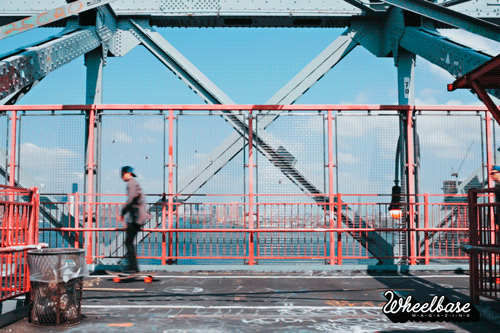Growing up in a relatively rural Northern California town I wasn’t exposed to very many large and/or well-paved riding surfaces. The biggest places for us to skate were cul-de-sacs and long sidewalks—though most were covered with enough cracks, potholes and dirt to persuade even the most dedicated skateboarder to swap their board for a bicycle. On the well-paved side of things, we had some tennis courts and basketball courts, both of which were places where skateboarding was thoroughly frowned upon. Tickets were given out like lotion samples in SoHo, but my friends and I did what we could with what we had and found role models in the form of Rodney Mullen and Mike Vallely for their uncanny abilities to find opportunities within a “different” kind of terrain. Pushing, or “long distance skateboarding” as we’ve come to know it, did not exist for us back then other than as a means to get enough speed to ollie off the loading dock behind the prune packaging facility. It wasn’t until college that I realized skateboarding could be used as a legitimate form of transportation. Come to find out, all I needed were some large, soft wheels and I’d be set.

And then I came to New York and saw how much ground could actually be covered on a skateboard. Eight miles through the streets of Manhattan, dodging tourists & taxi cabs and timing the traffic lights proved to me how much I actually suck at pushing. Pushing, the most basic and fundamental part of skateboarding! That was two years ago. Since then I’ve befriended some locals and have learned the when’s, where’s, why’s and how’s of traffic surfing and subsequently used them to my advantage during my commutes. The pushboarding lifestyle is taken seriously by quite a few NYC locals, competing in various push races and pushing long distances “for fun”. Nick “Cool Hands” Collins is one of these locals. In addition to knowing which streets to take, he also knows how to make the right stops along the way. He’s a life-long New York City resident whose been commuting via skateboard to work for who-knows-how-long. A few years back, his daily commute covered 100+ blocks, skating from Manhattan’s Upper East Side, down Second Avenue, to the Lower East Side. He’s since relocated to Brooklyn where he runs the day-to-day at Bustin Boards’ Brooklyn Shop. His commute isn’t as strenuous, but the endurance is still there.
In Manhattan, the majority of the streets are paved well enough to get you where you need to go without foot-numbing vibrations. Some streets though are cobblestone garbage. I’m sure they “lend to the authenticity of the NYC experience”, but most of us have places to go and so sometimes we must hop on the sidewalk now and again. Some streets, if one should be so lucky to encounter them, offer the luxury of a smooth, paint coated bike lane for your rollyboarding pleasure. These well-paved thoroughfares will get you to your destination in an appropriate amount of time, so long as you plan ahead for (1) construction-induced detours and (2) spot checks. (If you’re lucky, they will be one and the same.) Assuming you time it right and all goes according to plan, you can even enjoy the classic spots along the way.
Lastly, if you’re unfamiliar with the whole long distance skateboarding thing and want to give it a shot, consider making the pilgrimage to NYC with the rest of us on the second Saturday of next month. We’ll be going for a stroll down Broadway as we make our way to a barbecue.
- Seth

6 Responses to New York Minute: Push